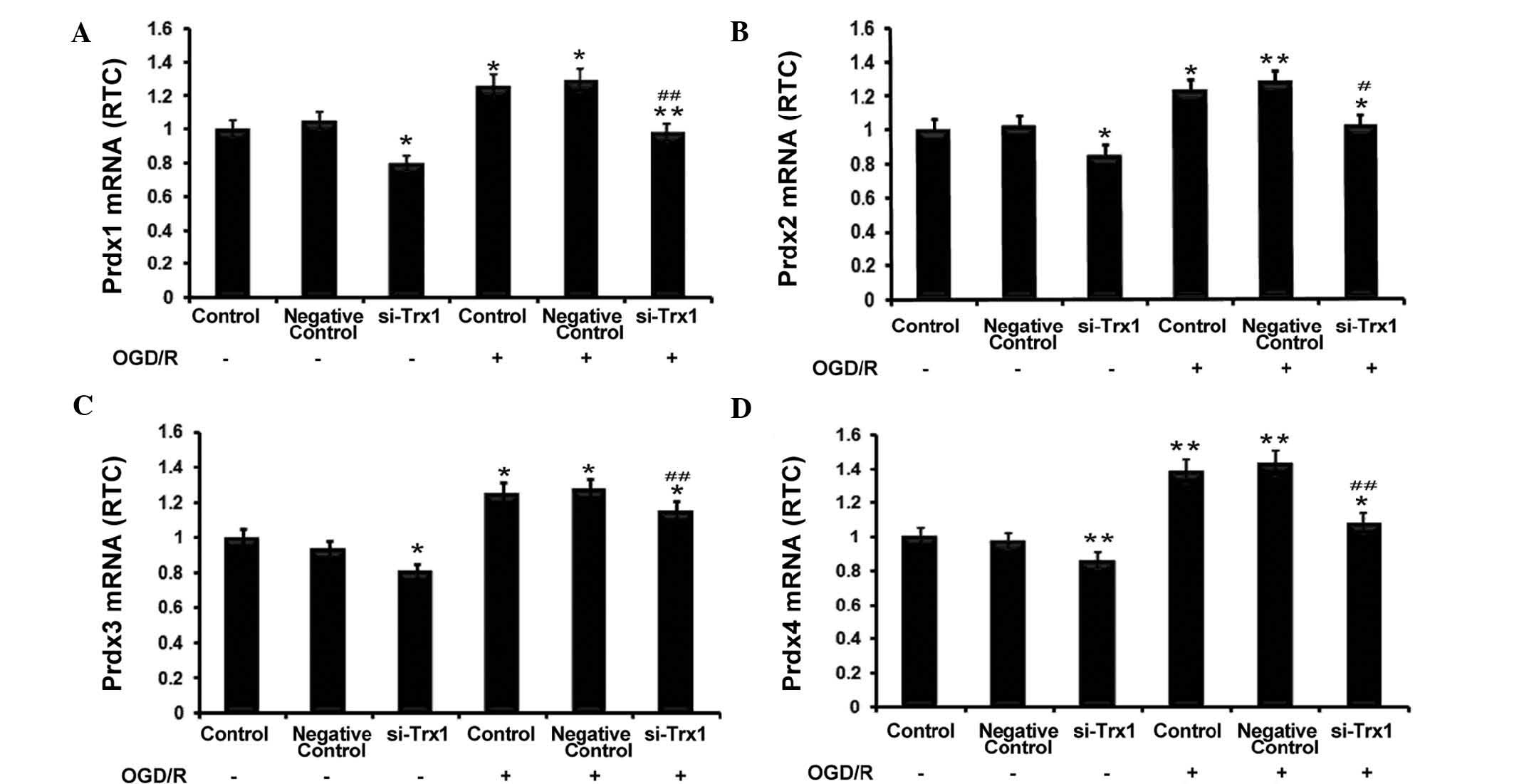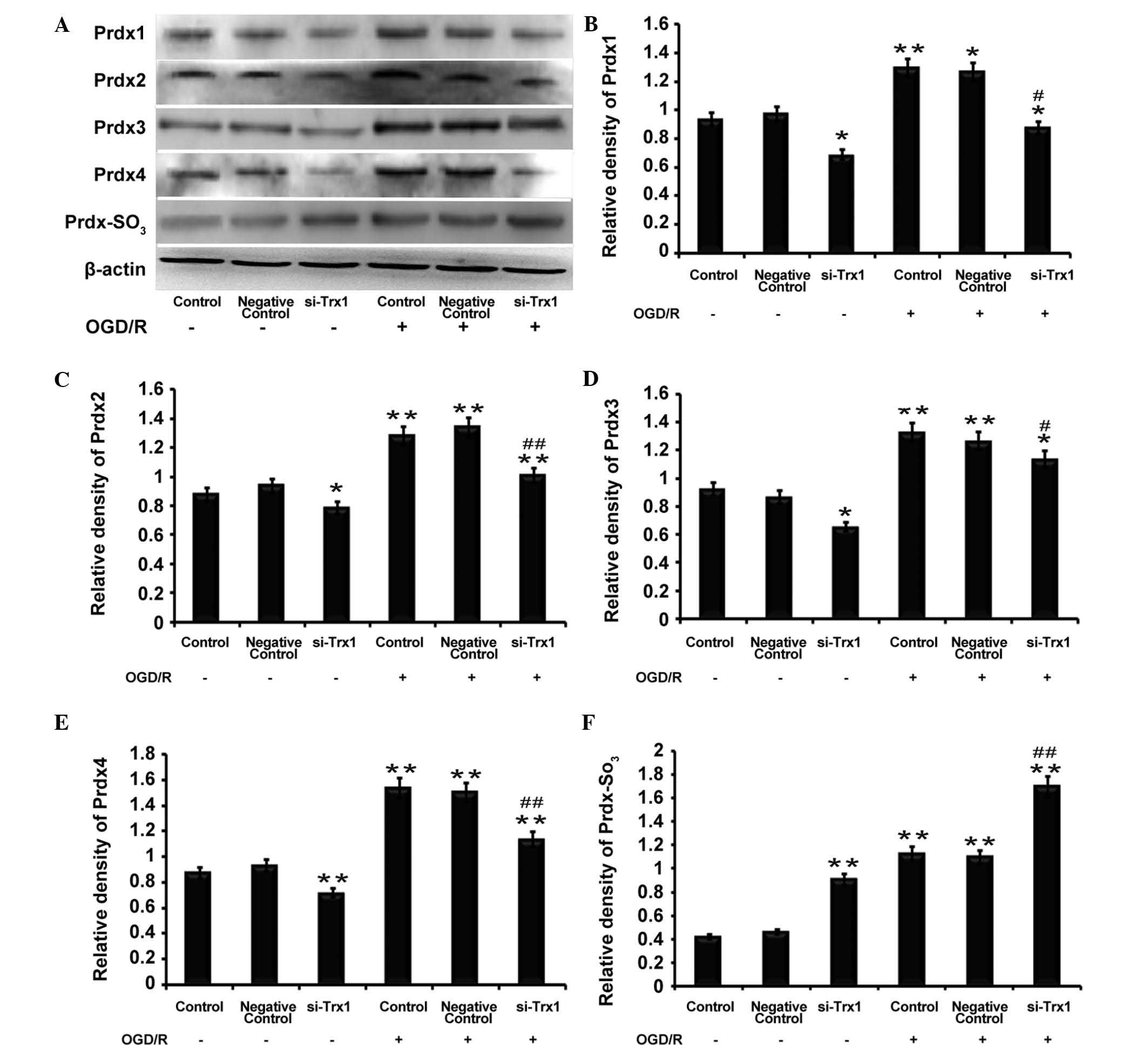|
1
|
Liu R, Liu H, Ha Y, Tilton RG and Zhang W:
Oxidative stress induces endothelial cell senescence via
downregulation of Sirt6. Biomed Res Int. 9028422014.PubMed/NCBI
|
|
2
|
Silva DG, Belini Junior E, de Almeida EA
and Bonini-Domingos CR: Oxidative stress in sickle cell disease: An
overview of erythrocyte redox metabolism and current antioxidant
therapeutic strategies. Free Radic Biol Med. 65:1101–1109. 2013.
View Article : Google Scholar : PubMed/NCBI
|
|
3
|
Calabrese V, Cornelius C, Mancuso C,
Pennisi G, Calafato S, Bellia F, Bates TE, Giuffrida Stella AM,
Schapira T, Dinkova Kostova AT and Rizzarelli E: Cellular stress
response: A novel target for chemoprevention and nutritional
neuroprotection in aging, neurodegenerative disorders and
longevity. Neurochem Res. 33:2444–2471. 2008. View Article : Google Scholar : PubMed/NCBI
|
|
4
|
Wood ZA, Poole LB and Karplus PA:
Peroxiredoxin evolution and the regulation of hydrogen peroxide
signaling. Science. 300:650–653. 2003. View Article : Google Scholar : PubMed/NCBI
|
|
5
|
Wood ZA, Schröder E, Robin Harris J and
Poole LB: Structure, mechanism and regulation of peroxiredoxins.
Trends Biochem Sci. 28:32–40. 2003. View Article : Google Scholar : PubMed/NCBI
|
|
6
|
Soriano FX, Léveillé F, Papadia S, Higgins
LG, Varley J, Baxter P, Hayes JD and Hardingham GE: Induction of
sulfiredoxin expression and reduction of peroxiredoxin
hyperoxidation by the neuroprotective Nrf2 activator
3H-1,2-dithiole-3-thione. J Neurochem. 107:533–543. 2008.
View Article : Google Scholar : PubMed/NCBI
|
|
7
|
Das KC and Das CK: Thioredoxin, a singlet
oxygen quencher and hydroxyl radical scavenger: Redox independent
functions. Biochem Biophys Res Commun. 277:443–447. 2000.
View Article : Google Scholar : PubMed/NCBI
|
|
8
|
Lu J and Holmgren A: Thioredoxin system in
cell death progression. Antioxid Redox Signal. 17:1738–1747. 2012.
View Article : Google Scholar : PubMed/NCBI
|
|
9
|
Pronk TE, van der Veen JW, Vandebriel RJ,
van Loveren H, de Vink EP and Pennings JL: Comparison of the
molecular topologies of stress-activated transcription factors
HSF1, AP-1, NRF2 and NF-κB in their induction kinetics of HMOX1.
Biosystems. 124:75–85. 2014. View Article : Google Scholar : PubMed/NCBI
|
|
10
|
Choi WJ: The Heterochromatin-1
phosphorylation contributes to TPA-Induced AP-1 expression. Biomol
Ther (Seoul). 22:308–313. 2014. View Article : Google Scholar
|
|
11
|
Chen B, Guan D, Cui ZJ, Wang X and Shen X:
Thioredoxin 1 downregulates MCP-1 secretion and expression in human
endothelial cells by suppressing nucleartranslocation of activator
protein 1 and redox factor-1. Am J Physiol Cell Physiol.
298:C1170–1179. 2010. View Article : Google Scholar : PubMed/NCBI
|
|
12
|
Livak KJ and Schmittgen TD: Analysis of
relative gene expression data expression data using real-time
quantitative PCR and the 2(-Delta Delta C (T)) Method. Methods.
25:402–408. 2001. View Article : Google Scholar
|
|
13
|
Xing G, Dong M, Li X, Zou Y, Fan L, Wang
X, Cai D, Li C, Zhou L, Liu J and Niu Y: Neuroprotective effects of
puerarin against beta-amyloid-induced neurotoxicity in PC12 cells
via a PI3K-dependent signaling pathway. Brain Res Bull. 85:212–218.
2011. View Article : Google Scholar : PubMed/NCBI
|
|
14
|
Guo H, Kong S, Chen W, Dai Z, Lin T, Su J,
Li S, Xie Q, Su Z, Xu Y and Lai X: Apigenin mediated protection of
OGD-evoked neuron-like injury in differentiated PC12 cells.
Neurochem Res. 39:2197–2210. 2014. View Article : Google Scholar : PubMed/NCBI
|
|
15
|
Sengupta R and Holmgren A: Thioredoxin and
thioredoxin reductase in relation to reversible S-nitrosylation.
Antioxid Redox Signal. 18:259–269. 2013. View Article : Google Scholar
|
|
16
|
Nickel C, Rahlfs S, Deponte M, Koncarevic
S and Becker K: Thioredoxin networks in the malarial parasite
Plasmodium falciparum. Antioxid Redox Signal. 8:1227–1239. 2006.
View Article : Google Scholar : PubMed/NCBI
|
|
17
|
Das DK: Thioredoxin regulation of ischemic
preconditioning. Antioxid Redox Signal. 26:405–412. 2004.
View Article : Google Scholar
|
|
18
|
Taksgi Y, Hatori I, Nozaki K, Mitsui A,
Ishikawa M, Hashimoto N and Yodoi J: Excitotoxic hippocampal injury
is atenuated in thioredoxin transgenic mice. J Cereb Blood Flow
Metab. 20:829–833. 2000.
|
|
19
|
Takagi Y, Horikawa F, Nozaki K, Sugino T,
Hashimoto N and Yodoi J: Expression and distribution of redox
regulatory protein, thioredoxin during transient focal brain
ischemia in the rat. Neurosci Lett. 251:25–28. 1998. View Article : Google Scholar : PubMed/NCBI
|
|
20
|
Mansur K, Iwashashi Y, Kiryu-Seo S, Su Q,
Namikawa K, Yodoi J and Kiyama H: Up-regulation of thioredoxin
expression in motor neurons after nerve injury. Brain Res Mol Brain
Res. 62:86–91. 1998. View Article : Google Scholar : PubMed/NCBI
|
|
21
|
Rhee SG, Kang SW, Jeong W, Chang TS, Yang
KS and Woo HA: Intracellular messenger function of hydrogen
peroxide and its regulation by peroxiredoxins. Curr Opin Cell Biol.
17:183–189. 2005. View Article : Google Scholar : PubMed/NCBI
|
|
22
|
Masutani H, Ueda S and Yodoi J: The
thioredoxin system in retroviral infection and apoptosis. Cell
Death Differ. 12(Suppl 1): 991–998. 2005. View Article : Google Scholar : PubMed/NCBI
|
|
23
|
Kondo N, Nakamura H, Masutani H and Yodoi
J: Redox regulation of human thioredoxin network. Antioxid Redox
Signal. 8:1881–1890. 2006. View Article : Google Scholar : PubMed/NCBI
|
|
24
|
Hwang IK, Yoo KY, Lee CH, Kim DW, Choi JH,
Kwon YG, Kim YM, Choi SY and Won MH: Changes in the expression of
mitochondrial peroxiredoxin and thioredoxin in neurons and glia and
their protective effects in experimental cerebral ischemic damage.
Free Radic Biol Med. 48:1242–1251. 2010. View Article : Google Scholar : PubMed/NCBI
|
|
25
|
Liu M, Wang Y, Zheng L, Zheng W, Dong K,
Chen S, Zhang B and Li Z: Fasudil reversed MCT-induced and chronic
hypoxia-induced pulmonary hypertension by attenuating oxidative
stress and inhibiting the expression of Trx1 and HIF-1α. Respir
Physiol Neurobiol. 201:38–46. 2014. View Article : Google Scholar : PubMed/NCBI
|
|
26
|
Bloomfield KL, Osborne SA, Kennedy DD,
Clarke FM and Tonissen KF: Thioredoxin-mediated redox control of
the transcription factor Sp1 and regulation of the thioredoxin gene
promoter. Gene. 319:107–116. 2003. View Article : Google Scholar : PubMed/NCBI
|
|
27
|
Kim YC, Yamaguchi Y, Kondo N, Masutani H
and Yodoi J: Thioredoxin-dependent redox regulation of the
antioxidant responsive element (ARE) in electrophile response.
Oncogene. 22:1860–1865. 2003. View Article : Google Scholar : PubMed/NCBI
|
|
28
|
Tanito M, Masutani H, Kim YC, Nishikawa M,
Ohira A and Yodoi J: Sulforaphane induces thioredoxin through the
antioxidant-responsive element and attenuates retinal light damage
in mice. Invest Ophthalmol Vis Sci. 46:979–987. 2005. View Article : Google Scholar : PubMed/NCBI
|
|
29
|
Papadia S, Soriano FX, Léveillé F, Martel
MA, Dakin KA, Hansen HH, Kaindl A, Sifringer M, Fowler J, Stefovska
V, et al: Synaptic NMDA receptor activity boosts intrinsic
antioxidant defenses. Nat Neurosci. 11:476–487. 2008. View Article : Google Scholar : PubMed/NCBI
|
|
30
|
Soriano FX, Baxter P, Murray LM, Sporn MB,
Gillingwater TH and Hardingham GE: Transcriptional regulation of
the AP-1 and Nrf2 target gene sulfiredoxin. Mol Cells. 27:279–282.
2009. View Article : Google Scholar : PubMed/NCBI
|
|
31
|
Wei Q, Jiang H, Matthews CP and Colburn
NH: Sulfiredoxin is an AP-1 target gene that is required for
transformation and shows elevated expression in human skin
malignancies. Proc Natl Acad Sci USA. 105:19738–19743. 2008.
View Article : Google Scholar : PubMed/NCBI
|



















